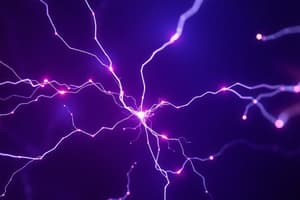Podcast
Questions and Answers
Which of the following is not a property of electric charges?
Which of the following is not a property of electric charges?
- Conservation
- Induction
- Conversion (correct)
- Attraction and repulsion
What is the SI unit of electric charge?
What is the SI unit of electric charge?
- Volt
- Ohm
- Coulomb (correct)
- Ampere
What is electrostatics?
What is electrostatics?
Electrostatics is the study of stationary electric charges and the forces they exert on each other.
Which of the following is an example of an insulator?
Which of the following is an example of an insulator?
What are the two types of electric charges?
What are the two types of electric charges?
What is the law of conservation of charge?
What is the law of conservation of charge?
Choose the correct option.
i. A positively charged glass rod is brought
close to a metallic rod isolated from
ground. The charge on the side of the
metallic rod away from the glass rod will
be
(A) same as that on the glass rod and equal
in quantity
(B) opposite to that on the glass of and
equal in quantity
(C) same as that on the glass rod but lesser
in quantity
(D) same as that on the glass rod but more
in quantity
ii. An electron is placed between two
parallel plates connected to a battery. If
the battery is switched on, the electron
will
(A) be attracted to the +ve plate
(B) be attracted to the -ve plate
(C) remain stationary
(D) will move parallel to the plates
iii. A charge of + 7 µC is placed at the centre
of two concentric spheres with radius 2.0
cm and 4.0 cm respectively. The ratio of
the flux through them will be
Choose the correct option. i. A positively charged glass rod is brought close to a metallic rod isolated from ground. The charge on the side of the metallic rod away from the glass rod will be (A) same as that on the glass rod and equal in quantity (B) opposite to that on the glass of and equal in quantity (C) same as that on the glass rod but lesser in quantity (D) same as that on the glass rod but more in quantity ii. An electron is placed between two parallel plates connected to a battery. If the battery is switched on, the electron will (A) be attracted to the +ve plate (B) be attracted to the -ve plate (C) remain stationary (D) will move parallel to the plates iii. A charge of + 7 µC is placed at the centre of two concentric spheres with radius 2.0 cm and 4.0 cm respectively. The ratio of the flux through them will be
Flashcards are hidden until you start studying
Study Notes
Properties of Electric Charges
- Electric charges can be positive or negative
- Like charges repel and unlike charges attract
- Charges can be transferred from one object to another
- The SI unit of charge is the coulomb (C)
- The charge on an electron is -1.6 x 10-19 C
- The charge on a proton is +1.6 x 10-19 C
Electrostatics
- Electrostatics is the study of stationary electric charges and their interactions
Insulator
- An insulator is a material that resists the flow of electric current
- Example of insulator: Rubber
Law of Conservation of Charge
- The total charge in an isolated system remains constant
- Charges can be transferred from one object to another, but the total amount of charge remains the same
Multiple Choice Questions
- **Question 1: ** The correct option is (B) opposite to that on the glass of and equal in quantity
- When a positively charged glass rod is brought close to a metallic rod, the electrons in the metal will be attracted to the glass rod
- This will cause the side of the metallic rod closest to the glass rod to become negatively charged, while the side of the metallic rod farthest from the glass rod will become positively charged
- **Question 2: ** The correct option is (A) be attracted to the +ve plate
- When the battery is switched on, an electric field is created between the plates
- Electrons are negatively charged and will be attracted to the positive plate
- **Question 3: ** The correct option is 1:1
- The electric flux through a closed surface is proportional to the enclosed charge
- Since the charge is at the center of both spheres, the amount of charge enclosed by each sphere is the same
- Therefore, the ratio of the flux through the two spheres will be 1:1
Studying That Suits You
Use AI to generate personalized quizzes and flashcards to suit your learning preferences.




